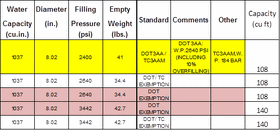I recently started researching on this subject because I just got a couple of LP108's, so please correct me if I state something wrong.
It seems the 3AA certification is not exclusive to just scuba cylinders. Pressurized cylinders used in other capacities also use that certification. Those other capacities require some extra conservatism in terms of the pressure each cylinder is supposed to handle safely. Because of this, scuba cylinders can get exemption certifications that are not as conservative as the 3AA.
It is common to find 3AA certified LP scuba cylinders. HP scuba cylinders usually have an exemption certification. In other words, 3AA LP's meet higher standards. Therefore it is logical to see that their certified rated pressure is lower than HP's which use looser standards.
I got this chart from the faber website. I added the last column myself.

You can see that all cylinders in the chart have the same diameter and internal volume. Unless they have shoulders/bottoms of different thicknesses, we can assume that the all 5 cylinders also have the same external dimensions. The cylinders marked in pink are US only versions since they have no TC certification. Only the cylinder marked in yellow is 3AA certified. This one weighs 41 lbs. The HP version of this cylinder weighs almost 43 lbs. If both of them have the same dimensions, the difference in weight would have to be explained by the use of a denser steel alloy.
Like wise the exemption certified LP versions weigh only 34 lbs. Following the same logic we can conclude that they use a less dense alloy for these tanks.
In light of this, I would feel fairly safe
routinely filling the 3AA certified cylinder to 3000 psi and would not expect the tank to fail hydros or show any other signs of metal fatigue. I would even feel ok
occasionally filling it to 3442 psi for dives where I'll need 140 cu ft per tank.





